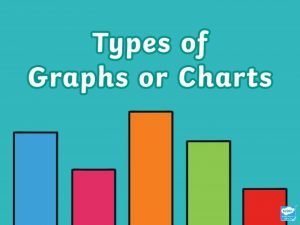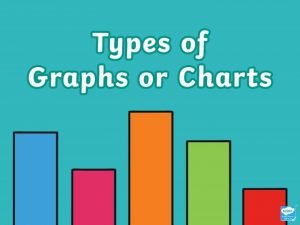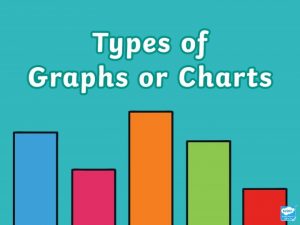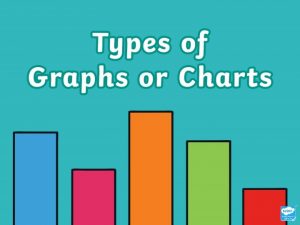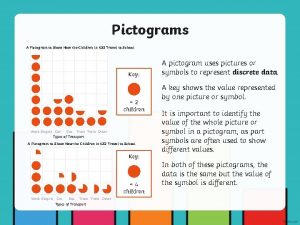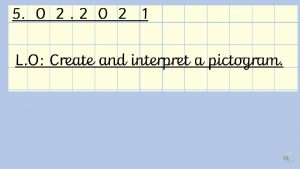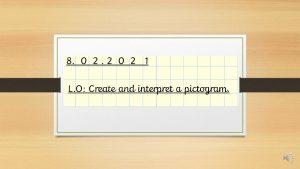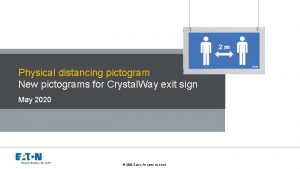Pictograms A Pictogram to Show How the Children







- Slides: 7


Pictograms A Pictogram to Show How the Children in KS 2 Travel to School Key: =2 children Walk Bicycle Car Bus Tram Train Other Types of Transport A Pictogram to Show How the Children in KS 2 Travel to School Key: =4 children Walk Bicycle Car Bus Tram Train Other Types of Transport A pictogram uses pictures or symbols to represent discrete data. A key shows the value represented by one picture or symbol. It is important to identify the value of the whole picture or symbol in a pictogram, as part symbols are often used to show different values. In both of these pictograms, the data is the same but the value of the symbol is different.

Bar Charts Data that is counted and has no in-between value is called discrete data. Discrete data is usually collected in a frequency table and then presented as a bar chart. Pet Cat Dog Fish Rabbit Other A bar chart has a horizontal axis and a vertical axis. • A bar chart must always have a title explaining what it shows. • Each bar must be the same width. A number line is marked on the vertical axis. The scale of this number line is chosen based on the data range. The data categories are organised on the horizontal axis. Each axis must have a label explaining what it shows. 14 12 Number of Children • There must be a gap between each bar. A Bar Chart to Show How Many Pets Y 6 Have 16 • Bars must be carefully drawn to show the data. Number of Children 12 14 7 5 8 10 8 6 4 2 0 Cat Dog Fish Type of Pet Rabbit Other

Bar Charts Discrete data in each category can also be represented in subcategories: Number of Girls Cat 7 5 Dog 6 8 Fish 3 4 Rabbit 1 4 Other 2 6 We can draw a grouped bar chart to show this data. In this bar chart, each category has more than one bar. A key is used to identify the subcategories of the data. A Bar Chart to Show How Many Pets Y 6 Have Number of Boys Number of Girls 10 9 Number of Children Pet Number of Boys 8 7 6 5 4 3 2 1 0 Cat Dog Fish Type of Pet Rabbit Other

Line Graphs Line graphs are used to show changes to a measurement over time. They show continuous data. The data being measured is shown on the vertical axis. The time the data is being measured over is shown on the horizontal axis. Data is plotted on to a line graph in the same way as a coordinate grid. These data plots are then joined with straight lines. We can use the line of the graph to describe general trends in the change of the measurement over time, or to find precise measurements at a given time. A Line Graph to Show the Temperature of the Classroom

Pie Charts Pie charts show discrete data as proportional sectors of a circle. Every sector of a pie chart is a proportion of the whole. You can explain what each sector represents using an angle, fraction or percentage. Being able to convert between fractions, percentages and angles is a key skill for answering questions about data presented in a pie chart. We can use fraction, percentage and angle equivalents to interpret the data in a pie chart. If the whole pie chart represents 120, the value of the orange sector is 60.

